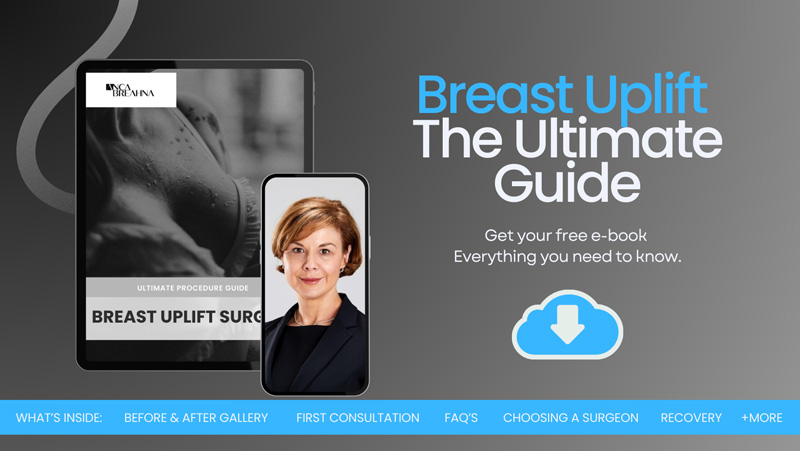
Pencil Test – A Simple Way to Determine If You’re a Candidate for Breast Uplift
Have you ever wondered if a breast uplift might be right for you? The “Pencil Test” is a simple, informal method that many women use to determine if a breast uplift might be beneficial. But what exactly does this test entail, and how reliable is it? Guided by the expertise of Anca Breahna, a leading Consultant Plastic Surgeon in the UK, this blog post will explore these questions and more.
Download the Breast Uplift Guide

What is the “Pencil Test”?
The “Pencil Test” is a popular method used by many to evaluate the degree of breast sagging. To perform this test, one simply places a pencil horizontally under the breast where it meets the rib cage and then releases the breast. If the pencil remains in place, held up by the breast tissue instead of falling to the ground, it suggests that the breast has a certain level of sagging. This outcome indicates that the breast tissue has lost some of its natural elasticity and firmness, which can make the woman a potential candidate for a breast uplift procedure.
The rationale behind the “Pencil Test” is based on the principle that healthy, youthful breast tissue typically has enough internal support to not trap objects against the chest. However, over time, factors such as ageing, the force of gravity, hormonal changes, pregnancy, and breastfeeding can take a toll on the breast’s supportive tissues. These factors can stretch the skin and ligaments of the breast, leading to a change in shape and position. Weight fluctuations can also significantly impact breast volume and skin elasticity, further contributing to sagging. The “Pencil Test” serves as a rudimentary gauge for these changes, offering a quick reference point for women contemplating the need for surgical intervention to restore a more youthful breast profile.
Limitations of the Pencil Test
While the “Pencil Test” can be a quick and easy way to guess at breast sagging, it has significant limitations. Firstly, it is not a medical assessment and does not take into account many factors that a plastic surgeon would consider during a professional evaluation. For instance, the test does not consider the overall shape, volume, skin quality, or the position of the nipples, all of which are crucial for determining the appropriateness and scope of a breast uplift.
Moreover, the outcome of the pencil test can vary greatly depending on how it’s performed, who performs it, and even the time of day. Such variability makes it an unreliable method for making decisions about surgery. It is also worth noting that some breasts may pass the pencil test but still benefit from uplift surgery due to other aesthetic concerns, such as asymmetry or nipple position.
The Role of Professional Assessment
Given the limitations of the “Pencil Test,” consulting with a qualified plastic surgeon like Anca Breahna is essential. During a professional consultation, Anca evaluates not just the degree of sagging, but also skin quality, breast volume, overall body shape, and personal aesthetic goals. This assessment is important as it helps tailor the surgical approach to your specific needs.
A professional evaluation also considers the potential benefits and risks of surgery, ensuring that you receive a balanced view before making any decisions. Anca discusses various surgical options and techniques that might be used during a breast uplift, providing a realistic expectation of the outcomes. This discussion also includes an honest conversation about what surgery can and cannot achieve, helping to set achievable goals.
The Consultation Process for a Breast Uplift
The journey towards breast uplift surgery begins with an initial consultation. During this first visit, you can expect a complex evaluation that includes a detailed physical examination and an in-depth discussion of your aesthetic goals. Anca will assess the size, shape, and symmetry of your breasts, as well as skin quality and the positioning of your nipples. This information helps her understand your natural anatomy and the possible enhancements that can be achieved through surgery.
This consultation also serves as an opportunity for you to express your desires and expectations. Anca encourages an open dialogue, ensuring that any questions or concerns you have about the procedure are addressed. This process is vital for establishing a trusting patient-surgeon relationship and for setting realistic goals for the surgery’s outcomes.
Choosing the right surgical approach for a breast uplift is a decision that Anca navigates with great care and expertise. Based on the initial consultation, she will recommend the most suitable surgical options that align with your body type and desired outcomes. This may involve choosing between different types of lifts—such as periareolar, vertical, or inverted T incisions—each tailored to address specific levels of sagging and aesthetic goals.
Anca’s approach is grounded in creating a balanced and natural-looking result that harmonises with your overall body shape. She will explain the implications of each surgical option, including the expected scars, potential risks, and the likely recovery trajectory. This detailed discussion helps you make an informed decision, ensuring that the chosen method aligns with your personal health considerations and lifestyle.
Preparation for Surgery
Once you have decided to proceed with the surgery, Anca will guide you through the necessary preparations to ensure a safe and successful outcome. This includes medical evaluations or lab tests to assess your general health. You may be asked to adjust or halt certain medications to avoid complications during and after surgery.
Lifestyle adjustments, such as quitting smoking and avoiding certain anti-inflammatory drugs that can increase bleeding, are also important. Anca will provide specific instructions regarding fasting before the operation and arranging for someone to drive you home post-surgery. Ensuring you have a comfortable recovery area set up at home with all the essentials within easy reach will also be discussed.
Overview of the Breast Uplift Surgery
Breast uplift surgery is a procedure designed to raise and reshape sagging breasts. Over time, factors such as gravity, pregnancy, breastfeeding, and weight fluctuations can cause the breasts to lose their elasticity and firmness. Mastopexy addresses these issues by removing excess skin, tightening the surrounding tissue, and repositioning the nipples and areolae to a more youthful height.
Women opt for a breast uplift for various reasons. Ageing naturally causes the skin to lose elasticity, leading to a droopy appearance. Pregnancy and breastfeeding can significantly alter the size and shape of the breasts, often leaving them stretched and sagging. Significant weight loss can also result in a similar loss of volume and firmness. A breast uplift can reverse these changes by restoring a more aesthetically pleasing and youthful breast contour.
The benefits of breast uplift surgery go beyond enhanced appearance. The procedure can boost your self-confidence and allow you to wear clothes that fit better. It also helps in achieving a more proportionate body contour, enhancing overall body image. Women often report psychological benefits, including increased self-esteem and satisfaction with their body image.
How Is a Breast Uplift Surgery Performed?
Anca employs different techniques for breast uplift surgery, tailored to the specific needs of each patient. The periareolar lift, for instance, is suitable for those with mild sagging. It involves a circular incision around the areola. For moderate sagging, a vertical lift, which includes an incision around the areola and down to the breast crease, may be ideal. The inverted T or anchor lift is used for significant sagging and involves an anchor-shaped incision pattern to allow for extensive reshaping.
On the day of the surgery, you will be administered anaesthesia for your comfort during the procedure. Anca will follow the pre-marked incision lines to remove excess skin and lift the breast tissue. Depending on your specific case, adjustments to the size and position of the areola might also be made. The incisions are then carefully closed with sutures.
Recovery and Aftercare
Post-surgery, you will receive detailed instructions regarding care for your breasts, medications to apply or take orally to aid healing and reduce the risk of infection, and when to follow-up with Anca. Initial healing typically involves swelling and discomfort, which can be controlled with medications. Most patients can return to work within a week or two, although exercise and heavy lifting should be avoided for at least a month to ensure optimal healing.
FAQs about Breast Uplift Surgery
How long do the results of a breast uplift last?
- The longevity of breast uplift results can vary greatly among patients, depending on factors such as age, genetics, and lifestyle. Typically, the results are long-lasting, especially if you maintain a stable weight and follow a healthy lifestyle. However, natural ageing and gravity will eventually affect the breasts, potentially leading to some sagging over time. Wearing supportive bras and avoiding significant weight fluctuations can help preserve the results for many years.
Are there any risks associated with breast uplift surgery?
- As with any surgical procedure, breast uplift surgery carries some risks. Common risks include reactions to anaesthesia, bleeding, infection, and scarring. There can also be temporary changes in breast or nipple sensation. More rare complications might include poor healing, which can lead to more significant scarring or loss of nipple tissue. Anca takes extensive precautions to minimise these risks and will discuss how to reduce potential complications during your consultation.
How do I maintain my results after a breast uplift?
- Maintaining the results of your breast uplift involves several lifestyle adjustments. It is important to keep your weight stable, as weight gain or loss can cause changes in breast size and shape. Regular exercise can help maintain overall body shape and skin elasticity, but it’s important to wear supportive sports bras to prevent sagging. Avoid smoking, as it can impair blood flow and affect the healing process, potentially worsening scars. Following Anca’s specific post-operative care instructions is also essential for maintaining the best possible results.
Can I combine a breast uplift with other procedures?
- Yes, it is quite common to combine a breast uplift with other procedures, especially breast augmentation (with implants) or breast reduction. Combining procedures can address both sagging and size concerns in one operation. This combination can help achieve superior improvements in breast appearance. Anca will discuss the possibilities and safety of combining surgeries based on your specific anatomical needs and aesthetic goals during your consultation.
What should I consider when choosing a surgeon for a breast uplift?
- Choosing the right surgeon is important for ensuring successful outcomes in breast uplift surgery. Look for a surgeon who has extensive experience in breast surgeries. It’s also important to review before-and-after photos of previous patients who have undergone similar procedures. During your consultation, evaluate how well the surgeon understands your goals and explains the procedure. A good rapport and clear communication are essential. Finally, consider patient testimonials and reviews to gauge the satisfaction level of past patients.
Further Reading about Breast Uplift Surgery with Consultant Plastic Surgeon Anca Breahna
- Read more about How to Fix Saggy Breasts – Breast Uplift, Breast Implants or Both
- Read more about What Do Breast Uplift Scars Look Like and How Can They Be Faded
- Read more about Internal Bra – A More Durable Breast Uplift Technique
- Read more about When Can I Exercise After Breast Uplift Surgery?
- Read more about Recovery Timeline after Breast Uplift (Mastopexy) Surgery
Medical References for Breast Uplift
- Breast Ptosis – StatPearls – NCBI Bookshelf
- What to Know About Sagging Breasts – WebMD
- Finesse in Mastopexy and Augmentation Mastopexy
- Mastopexy: with or without Acellular Dermal Matrix?
- Mastopexy and reduction mammoplasty pedicles and skin resection patterns


 Ms Anca Breahna, PhD, MSc, FEBOPRAS, FRCS (Plast) is a highly regarded Consultant Plastic Surgeon specialising in the field of Aesthetic and Reconstructive Plastic Surgery. Anca performs a range of
Ms Anca Breahna, PhD, MSc, FEBOPRAS, FRCS (Plast) is a highly regarded Consultant Plastic Surgeon specialising in the field of Aesthetic and Reconstructive Plastic Surgery. Anca performs a range of 